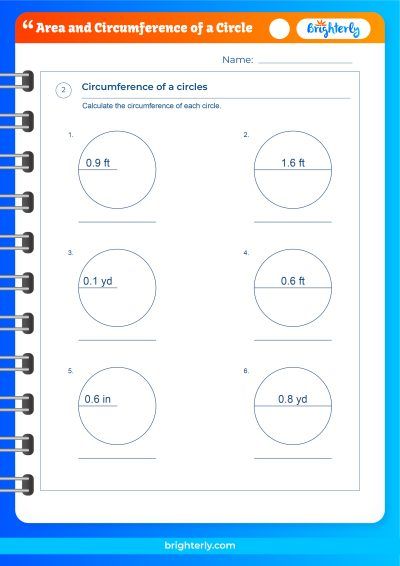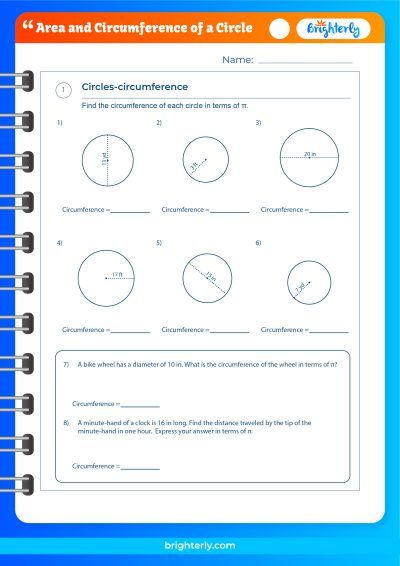Area of a Circle – Formula, Definition with Examples
Updated on January 11, 2024
Welcome to another fascinating exploration of geometry on Brighterly, where we illuminate the world of mathematics for children in an exciting and engaging way! Today, we turn our spotlight to a fundamental and ubiquitous shape in our world – the circle. Circles are everywhere! You’ll find them in the wheels of your bicycle, the sun and moon in the sky, the cookies you love to munch on, and even in the little round coins you use. But have you ever wondered about the mathematics hidden inside these perfect round figures? One of the most intriguing aspects of a circle is its area. The area of a circle may seem like a mystery, but with the magical wand of mathematics, we can reveal its secrets! So buckle up, young mathematicians, as we at Brighterly take you on a captivating journey through the remarkable world of circles, filled with enchanting formulas, exciting definitions, and enlightening examples!
What is a Circle?
A circle is a simple geometric shape that is all points in a plane equidistant from a fixed central point. It’s a common shape seen in daily life, from wheels and plates to logos and natural formations like raindrops or the sun. This fundamental shape has intrigued humans for centuries, paving the way for an in-depth study of its unique properties. A circle is characterized by its radius, diameter, circumference, and of course, its area. When we dive into the mathematics of a circle, we come across intriguing facts and formulas that allow us to measure these attributes. Knowing the ins and outs of a circle can help us solve a myriad of problems – not just in math class, but in the real world as well.
What is the Area of Circle?
The area of a circle refers to the amount of space that it encompasses within its boundary, or its circumference. Imagine you are painting a circular canvas. The amount of paint you would need to cover the entire canvas represents the circle’s area. In mathematical terms, the area is calculated using a specific formula involving the circle’s radius, and it is measured in square units. Understanding the concept of a circle’s area is pivotal not just for solving geometric problems but also for practical applications in fields such as engineering, architecture, and design.
Circle and Parts of a Circle
The circle is a beautiful symphony of several parts harmoniously coming together. The main components include the center, which is the fixed point from which all points on the circle are equidistant. The radius is the distance from the center to any point on the circle. The diameter is twice the radius, spanning the circle through its center. The circumference is the boundary or the length around the circle. Lastly, the chord is a line segment connecting any two points on the circle, with the diameter being the longest chord. Each of these parts plays a crucial role in calculating the area of a circle.
Area of Circle Formulas
The formula for the area of a circle is a staple in geometric calculations. It is defined as Area = πr^2, where r represents the radius of the circle and π (Pi) is a mathematical constant approximately equal to 3.14159. This formula enables us to determine the area with just the radius’s value. But what if we have the diameter or the circumference instead of the radius? Fear not, for the versatility of circle area formulas accommodates these variations too!
Using Areas of Rectangles
The area of a circle can be visualized using rectangles. If you divide a circle into numerous tiny sectors and rearrange these like a parallelogram (which closely resembles a rectangle), you can use the formula for the area of a rectangle (length x width) to find the area of the circle. This approach bridges the understanding of various shapes and underlines the interconnected nature of geometry.
Using Areas of Triangles
Similarly, triangles can be employed to understand the area of a circle. By dividing the circle into a multitude of triangular slices, it resembles a polygon. The area of these triangles can be summed up to approximate the circle’s area, and as the number of slices increases, the approximation gets more accurate. This method links the circle’s area to the formula for the area of a triangle (1/2 base x height).
At Brighterly, we believe that practice is the key to mastery. That’s why we invite you to explore our area of a circle worksheets, where you can find an array of additional practice questions, complete with answers.
Area of a Circle Using Diameter
While the standard area formula employs the radius, it can be adjusted to use the diameter (d) instead, as the diameter is twice the radius. Hence, the formula becomes Area = π(d/2)^2, which simplifies to Area = πd^2/4. This formula is especially useful when the diameter is known, eliminating the need for extra conversion steps.
Area of a Circle Using Circumference
If we know the circumference (C) of the circle, we can still calculate the area. Given the formula for circumference is C = 2πr, we can express the radius r as C/2π, substitute this into the area formula, resulting in Area = π(C/2π)^2. Simplifying this gives Area = C^2/4π, another handy variant of the circle area formula.
Area of a Circle – Calculation
The calculation of the area of a circle primarily involves plugging the known values into the suitable formula. Whether it’s using the radius, diameter, or circumference, the key is understanding the relationship between these parameters. Performing these calculations can be a thrilling exercise in precision and accuracy, further deepening the comprehension of circular geometry.
Derivation of Area of a Circle
The derivation of the circle’s area formula is a fascinating journey through mathematical reasoning. It commonly starts with visualizing the circle as composed of an infinite number of triangles with their apex at the center of the circle. Summing up the areas of these triangles leads to the universal formula Area = πr^2. This elegant derivation reaffirms the power and beauty of mathematical logic.
Surface Area of Circle Formula
The term ‘surface area’ usually refers to 3D shapes, but for a circle (a 2D shape), it’s the same as the area. Thus, the surface area formula of a circle reiterates Area = πr^2.
Differences Between Area and Circumference of a Circle
The circumference and area of a circle are both fundamental properties, but they signify different aspects. The circumference measures the boundary or perimeter, the ‘fence around the field’, if you will. On the other hand, the area quantifies the space enclosed within this boundary, the ‘field’ itself. While they both involve the radius and the constant π, they are distinct concepts with separate formulas and units of measurement.
Practice Questions on Area of Circle
Indeed, practice is a cornerstone of understanding and mastering any concept, and the area of a circle is no different. Here are some practice problems that will help reinforce your understanding of the concept. Remember, each question adds another layer to your understanding of this fascinating topic.
1. Find the area of a circle with a radius of 5 units.
To solve this, use the formula Area = πr^2. Here, r=5. Substituting these values, we get Area = π(5)^2 = 25π square units.
2. If the diameter of a circle is 14 units, what is the area of the circle?
First, remember that the diameter is twice the radius. Therefore, the radius is 7 units. Use the formula Area = πr^2 to find the area, giving Area = π(7)^2 = 49π square units.
3. What is the area of a circle with a circumference of 31.4 units?
To solve this, you need to first find the radius. The formula for the circumference is C = 2πr. Solving for r gives r = C/2π. Substituting C=31.4, we get r = 31.4/2π ≈ 5 units. Then, substitute r=5 into Area = πr^2 to find the area, which equals 25π square units.
4. If the area of a circle is 78.5 square units, what is its radius?
You need to rearrange the area formula Area = πr^2 to solve for r, giving r = sqrt(Area/π). Substituting Area=78.5, we get r = sqrt(78.5/π) ≈ 5 units.
Conclusion
And so, our enchanting journey through the world of circles comes to a close. We’ve unraveled the mystery of the circle’s area, delved deep into its formula, explored its various parts, and illuminated the fascinating connections between the circle and other geometric shapes. However, this is just the tip of the iceberg. With every circle you encounter in your daily life, there lies an opportunity to apply what you’ve learned, to appreciate the inherent beauty of geometry, and to cultivate your curiosity.
Remember, mathematics is a language that unlocks the hidden patterns of the universe, and circles, with their flawless symmetry and remarkable properties, are a testament to this. So the next time you see a circle, recall its beautiful secrets, for you now hold the keys to understanding this timeless shape.
Here at Brighterly, we believe that the world of mathematics is a playground filled with wonders, and we are thrilled to guide you in your exploration. Continue your journey, for every step brings a new revelation, a new joy, a new marvel. Until our next mathematical adventure, keep exploring, keep discovering, and keep lighting up your world with Brighterly!
Frequently Asked Questions on Area of Circle
Why is π used in the formula for the area of a circle?
π is a mathematical constant approximately equal to 3.14159. It represents the ratio of a circle’s circumference to its diameter. This unique ratio remains constant for all circles, regardless of their size, which is why π is used in the formulas for the circumference and area of a circle.
Can the area of a circle be negative?
No, the area of a circle cannot be negative. Area represents the amount of space enclosed by a shape and, as such, is always a positive quantity.
How can I calculate the area if I only have the circumference?
If you only have the circumference of a circle, you can still calculate its area. First, use the circumference to find the radius (r = Circumference/2π). Then, substitute the radius into the area formula (Area = πr^2) to get the area.
Why do we need to calculate the area of a circle?
Calculating the area of a circle has numerous practical applications. For instance, it can help determine the amount of material needed for a circular area, like a pizza or a round garden. Moreover, understanding the concept of a circle’s area is essential for various mathematical and scientific fields, including physics, engineering, and computer science.






